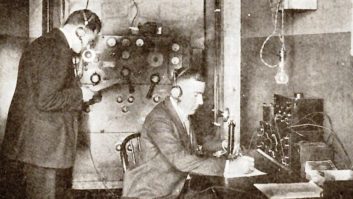Our cover story this issue about Dr. J.R. Brinkley was prompted in part by the publication earlier this year of a book that is now about to come out in soft-cover.

WLS technicians create sounds using plungers, cloth, roller skates, a sewing machine and a bass drum. ‘The strange contraption on the right may have been used to generate a wind or airplane sound.’ Courtesy Chris Cline
Let’s wrap up our gift discussion with more ideas for the book lover on your shopping list.
“Chicago’s WLS Radio” by Scott Childers — Of keen interest to fans of WLS will be this addition to the fabulous “Images of America” photo essay series you’ve seen in bookstores.
The “Images” series began with books about specific towns and cities — I have one about my hometown of Westfield, N.J. — and has expanded to include various industries, ethnic groups and other topics.
Readers will find numerous wonderful promotional and behind-the-scene pix not only of early station talents but of more recent notables like Art Vuolo, Kurt Hanson, Catherine Johns, Larry Lujack, Dick Orkin and Dick Biondi.
If you have any interest in the storied history of WLS, buy this soft-cover pictorial overview. Retail $19.99.
If Arcadia knows what’s good for it, the company would launch a full series of radio station history books in the mold of this WLS title. They’d have a hit.
A fun thing for a history-minded reader to do: Visit the Arcadia Web site, click on Images of America and browse the thousands of topics in print.

WLS Engineer Ed Glab works a remote in the Hometown Square gazebo at Mariott’s Great America. These two pix are from the book ‘Chicago’s WLS Radio.’ Courtesy John Gehron
Just within radio, the company has titles, in that series and in others, on topics such as broadcasting in Birmingham, Ala.; Detroit sports broadcasters; the history of WIVK(AM) in Knoxville, Tenn.; the “Cincinnati Sound”; and WNAX(AM) in Yankton, S.D. That book was co-written by a man who literally grew in its transmitter building.
“Clark Weber’s Rock and Roll Radio — 1955–1975, The Fun Years” by Clark Weber with Neal Samors — This book didn’t reach me in time to look over for this column but here’s the summary from the author:
“I’m Mother Weber’s Oldest Son Clark. I was very much a part of your rock and roll musical scene in the ’50s, ’60s and ’70s. As the program director and disc jockey at WLS radio in Chicago, I chose the music that was played on that 50,000 watt rock and roll giant. My new book is complete with dozens of pictures and a special CD that returns you to those fun years. Come with me and we’ll go back in time to when rock and roll was clean and the Chicago River was dirty.”
Published by Chicago’s Books Press, $37.50 hard, $29.50 soft.
“The HP Way” by David Packard — Not just a radio book but featuring first-person electronics and business history, this is a favorite of tech managers including Mike Dosch of Axia Audio.

“Catfish” recommended it to me as a fine example of how engineers can find corporate success.
Packard co-founded Hewlett-Packard with Bill Hewlett in the late 1930s with $538 and a coin toss to determine who would get top billing. Packard retired as chairman in 1993. Do you dream of turning a garage-based radio/audio business into something bigger? You’ll enjoy this.
Packard deals out his share of corporate platitudes about HP management; but this easy-to-read paperback is a pleasant excursion. Published by Collins Business Essentials in the mid-1990s, now in paperback, it retails for $14.95.
(Also on Dosch’s recommended list: “The Innovator’s Dilemma” by Clayton M. Christensen, published in 1997 and also part of the Collins series, about how “disruptive technologies” and traditional business practices overlap and diverge.)
“Passport to World Band Radio” — Here comes the 25th edition of a popular title we’ve reviewed in Radio World before.
This remarkable resource includes reviews of dozens of receivers and antennas; hour-by-hour descriptions of shows that can be heard in English; country-by-country schedules in English and other languages; frequency-by-frequency graphics of all channels and languages; and a look at developments in South America, where radio “serves as a powerful tool for the Colombian army, paramilitary squads, Marxist rebels, missionaries and drug runners.”
A handy tip sheet gives suggestions about the best times and frequencies to maximize the listening experience.
Published by International Broadcasting Services Ltd. Softcover, retails for $22.95.

“Mass Media Unleashed” by Carl R. Ramey — The subtitle of this 2007 book is “how Washington policymakers shortchanged the American public.” Ramey is a communications attorney (and former radio announcer) who thinks the country deserves better from its media policymakers.
His topics include consolidation, deregulation and what he considers the huge transformation of policy since 1980.
Ramey is realistic about such issues: “This is hardly a new debate,” he writes at one point. “For virtually its entire history broadcasting has been enthusiastically embraced by the masses while critics worried and complained that the medium was being controlled by too few owners whose sole motivation was profit.”
If you feel media are delivering less public service and that their concerns for the bottom line are deleterious to our society, you’ll find thoughtful discussion here.
You may however take issue with his provocative ideas for fixing media regulation. He proposes a three-part policy that would give commercial broadcasters permanent license status, expand antitrust enforcement and “reenergize” the public broadcasting system.
He would do away with the “public trusteeship” model of regulation for commercial broadcasting but retain that model for public stations (for instance, among his goals is a return to the Fairness Doctrine for public stations only).
The book is a thoughtful, academic, readable essay about the history of media policy and Ramey’s surprising views on what should be done next. Agree with him or not, it’s timely reading — perhaps for any new presidents of the United States or FCC commissioners out there.
Published by Rowan & Littlefield. Softcover, $29.95.

“Sounds of Change: A History of FM Broadcasting in America” by Christopher H. Sterling and Michael C. Keith — Suitable as a teaching reference (which is not surprising given that the authors are college professors), this book portions the history of FM radio into seven time periods: its creation (pre-1941), war and evolution (’41–45), the “dismal years” (’45–57), FM’s turnaround (’58–65), the period when the FM band was a “sound alternative” (’66–80), dominance (’80–95) and “clouds in the air” (everything since).
This is a non-technical and straightforward retelling of significant FM developments going back to Maj. Armstrong. It is intelligent and well documented, but broad rather than deep. The text is illustrated with some neat graphics such as a list of pioneering FM experimental stations in the 1930s, a chart of commercial FMs operating by late 1944 and a comparison of the holdings of the largest radio owners in 1996 compared to 2007.
Useful appendices provide numerous charts and five national maps showing how FM coverage has changed since 1945.
Published by the University of North Carolina Press, cloth $55.95, paperback $22.50.
And don’t forget “Charlatan: America’s Most Dangerous Huckster, the Man Who Pursued Him and the Age of Flim-Flam” by Pope Brock, about Dr. Brinkley the “Goat Gland Man,” currently in hardcover (I saw it on sale recently for less than $17) and due in paperback in January for $14.95 retail. Published by Crown.
The author is Radio World Editor in Chief/U.S.












